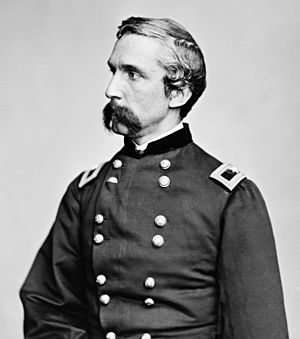Walter Goodale Morrill facts for kids
Quick facts for kids
Walter Goodale Morrill
|
|
|---|---|

Walter G. Morrill
|
|
| Born | November 13, 1840 Williamsburg, Maine, U.S. |
| Died | March 3, 1935 (aged 94) Pittsfield, Maine, U.S. |
| Buried |
Pittsfield Village Cemetery
|
| Allegiance | United States of America |
| Service/ |
United States Army Union Army |
| Years of service | 1861–1865 |
| Rank | |
| Unit | |
| Battles/wars | American Civil War • Second Battle of Rappahannock Station • Little Round Top at the Battle of Gettysburg |
| Awards | Medal of Honor |
Walter Goodale Morrill (1840–1935) was a brave soldier and officer in the Union Army during the American Civil War. He received the Medal of Honor, which is the highest award a U.S. soldier can get. He earned it for his actions at the Second Battle of Rappahannock Station in 1863. His earlier actions at Gettysburg in 1863 were also very important. They helped the Union win a key battle at Little Round Top.
Morrill grew up in Williamsburg, Maine. In 1861, when he was 20, he joined the army as a sergeant. He was part of Company A in the 6th Maine Volunteer Infantry Regiment. A year later, he became an officer in Company B of the 20th Maine Volunteer Infantry Regiment. He was promoted many times, eventually becoming a lieutenant colonel. He left the army on June 4, 1865.
Contents
Heroic Actions: Medal of Honor
Walter Morrill received the Medal of Honor for his bravery at the Second Battle of Rappahannock Station in Virginia. This battle happened on November 7, 1863. Morrill was a captain in the 20th Maine Volunteers at the time.
He was with a group of skirmishers, who are soldiers sent ahead to scout or fight in small groups. He learned that other soldiers were planning to attack the enemy's forts. Morrill asked for volunteers from his own group to join the attack. About 50 soldiers stepped forward.
Morrill and his volunteers joined another group, the 6th Maine regiment. Together, they charged the enemy's defenses. They used bayonets, which are knives attached to rifles, to fight. They successfully took over the enemy's positions. During this attack, they captured four cannons, eight battle flags, and 1,300 enemy soldiers. Captain Morrill was specially praised for his actions in official army reports.
Saving Little Round Top at Gettysburg
Morrill also played a very important role at the Battle of Gettysburg in July 1863. This battle included a famous fight at a place called Little Round Top. Morrill led his unit in a key bayonet charge without waiting for orders.

His group made it seem like two whole regiments were rushing through the woods. But it was actually only 44 soldiers from Company B and 14 U.S. Sharpshooters. A Confederate officer, Lieutenant Colonel William C. Oates, thought Morrill's sudden attack caused panic among his Confederate soldiers.
Without Morrill's surprise attack from the Confederates' right side, the famous bayonet charge led by Joshua Chamberlain might have failed. Chamberlain's charge is often given credit for saving Little Round Top and helping the Union win at Gettysburg.
As the Confederates retreated, Morrill's Company B of the 20th Maine fired their rifles at them. A few 2nd U.S. Sharpshooters, hidden behind a stone wall, also fired. This group, hidden from sight, caused a lot of confusion among the retreating Confederate soldiers.
What Others Said About Little Round Top
Brigadier General Oates, the Confederate officer, later said that Colonel Chamberlain's skill and the bravery of his men saved Little Round Top. He believed this also helped save the entire Union Army of the Potomac from defeat.
Oates thought that if just one more Confederate regiment had attacked the far left of the Union army, they would have won Little Round Top. This would have forced the Union's whole left side to retreat. He concluded that "great events sometimes turn on comparatively small affairs."
Colonel Chamberlain himself wrote in his report that Captain Morrill and his skirmishers "fell upon the enemy as they were breaking." He added that Morrill's actions and accurate firing "added much to the effect of the [bayonet] charge." This charge helped clear the area in front of nearly the entire Union brigade.
Life After the War
Walter Morrill led troops in many other battles, including the final one at Appomattox. After the war, he became a successful businessman in Pittsfield, Maine.

